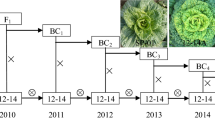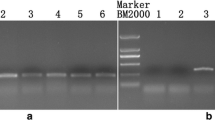Abstract
Cytoplasmic male sterility is an important biological tool which is now available to pigeonpea breeders to exploit heterosis/hybrid vigor. A variety of CMS systems have been developed when wild relatives of pigeonpea from different gene pools were crossed as the female parent with cultivated types as the male parent. This paper reports a second source of CMS developed by using the cultivated pigeonpea as the female parent and one of its wild relative Cajanus lanceolatus (WV Fitgz) van der Maesen as the pollen donor, as such the A5 CMS system derived from C. acutifolius. All the F1 hybrids were evaluated to confirm hybridity using 27 simple sequence repeat (SSR) markers. SSR marker analysis of parents provided 17 polymorphic markers from a total of 27 SSR markers used. Subsequently polymorphic SSRs were used to confirm the hybridity of the F1 plants. F1 hybrid plants were crossed with a range of pigeonpea cultivars to identify maintainers of male sterility. Morphology of the F1 and backcross generations, cytology of the sterile as well as fertile floral buds derived from the crosses between sterile F1 hybrids and unrelated pigeonpea cultivars were studied. An important observation made was that male sterility was a post meiotic process. Microsporogenesis was normal until the tetrad stage, but none of them formed pollen grains. Instead, they grouped together within the pollen mother cell wall and the tetrads did not separate into individual pollen grains.






Similar content being viewed by others
References
Alexander MP (1969) Differential staining of aborted and nonaborted pollen. Stain Technol 44:117–122
Bohra A, Dubey A, Saxena RK, Penmetsa RV, Poornima KN, Kumar N, Farmer AD, Srivani G, Upadhyaya HD, Gothalwal R, Ramesh S, Singh D, Saxena K, Kishor PBK, Singh NK, Town CD, May GD, Cook DR, Varshney RK (2011) Analysis of BAC-end sequences (BESs) and development of BES-SSR markers for genetic mapping and hybrid purity assessment in pigeonpea (Cajanus spp.). BMC Plant Biol 11(1):15
Kaul CL, Singh SP (1969) Validity of stain tests in determining pollen viability of some papilionaceous plants. Indian J Agric Sci 39:1050–1055
Kumar RV, Saxena KB (2013) Wild relatives of pigeonpea—an important resource for developing CMS systems. http://icrisat.agropedia.in/sites/default/files/Wild relatives of Pigeonpea new (new).pdf. Accessed Oct 2013
Malikarjuna N, Kalpana N (2004) Mechanisms of Cytoplasmic nuclear male sterility in pigeonpea wide cross C. cajan X C. acutifolius. Indian J Genet 64:115–117
Mallikarjuna N, Moss JP (1995) Production of hybrids between Cajanus platycarpus and Cajanus cajan. Euphytica 83(1):43–46
Mallikarjuna N, Saxena KB (2005) A new cytoplasmic nuclear male-sterility system derived from cultivated pigeonpea cytoplasm. Euphytica 142:143–148
Mallikarjuna N, Jadhav DR, Srikanth S, Saxena KB (2011) Cajanus platycarpus (Benth.) Maesen as the donor of new pigeonpea cytoplasmic male sterile (CMS) system. Euphytica 182:65–71
Mallikarjuna N, Jadhav DR, Saxena KB, Srivastava RK (2012) Cytoplasmic male sterile systems in pigeonpea with special reference to A7 CMS. Electron J Plant Breed 3:983–986
O’Brien TP, Feder N, Mc Cully ME (1964) Polychromatic staining of plant cell walls by toluidine blue O. Protoplasma 59:368–373
Pathak P, Sudi R, Wani SP, Sahrawat KL (2013) Hydrological behavior of Alfisols and Vertisols in the semi-arid zone: Implications for soil and water management. Agric Water Manage 118:12–21
Reddy BVS, Green JM, Bisen SS (1978) Genetic male-sterility in pigeonpea. Crop Sci 18:362–364
Saxena KB (2006) Seed production systems in pigeonpea. International Crops Research Institute for the Semi-Arid Tropics, Patancheru, p 76. ISBN 92-9066-490-8
Saxena KB (2013) A novel source of CMS in pigeonpea derived from Cajanus reticulatus. Indian J Genet Plant Breed 73:259–263
Saxena KB, Singh L, Gupta MD (1990) Variation for natural out-crossing in pigeonpea. Euphytica 46:143–148
Saxena KB, Sultana R, Mallikarjuna N, Saxena RK, Kumar RV, Sawargaonkar SL, Varshney RK (2010) Male-sterility systems in pigeonpea and their role in enhancing yield. Plant Breed 129:125–134
Srikanth S, Rao MV, Mallikarjuna N (2013) Interspecific hybridization between Cajanus cajan (L.) Millsp. and C. lanceolatus (WV Fitgz) van der Maesen. Plant Genet Resour. doi:10.1017/S1479262113000361
Virnich H (1967) Untersuchungen uber das Verhalten der mannlichen Sterilitat und anderer Eigenschaften bei polyploiden Zwiebeln (Allium cepa L.) als Grundlage fur eine Nutzung in der Hybrid. Auchtung Zeits Pflanzenzucht 58:205–244
Author information
Authors and Affiliations
Corresponding author
Rights and permissions
About this article
Cite this article
Srikanth, S., Saxena, R.K., Rao, M.V. et al. Development of a new CMS system in pigeonpea utilizing crosses with Cajanus lanceolatus (WV Fitgz) van der Maesen. Euphytica 204, 289–302 (2015). https://doi.org/10.1007/s10681-014-1321-z
Received:
Accepted:
Published:
Issue Date:
DOI: https://doi.org/10.1007/s10681-014-1321-z




